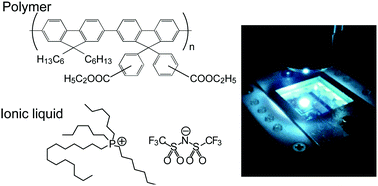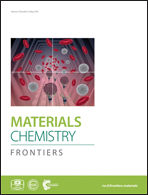An ester-substituted polyfluorene derivative for light-emitting electrochemical cells: bright blue emission and its application in a host–guest system†
Abstract
The unique interaction of electrons and ions in film blends of light-emitting polymers and electrolytes can realize the operation of light-emitting electrochemical cells (LECs) in which voltage-induced dynamic p–n homojunctions achieve efficient light emission. A crucial issue is the compatibility between the light-emitting polymers and electrolytes; the phase incompatibility of polymers and electrolytes makes it difficult to prepare uniform film blends suitable for the light-emitting layers of LECs. Here, we report that the introduction of ester groups into a light-emitting polymer improves phase compatibility with an ionic liquid-based electrolyte with high electrochemical stability. The resulting uniform film blends of the light-emitting polymer and electrochemically stable ionic liquid contributed significantly to making LECs more efficient and brighter; 60 000 cd m−2 of luminance with a high efficiency of 9 cd A−1 was demonstrated. Furthermore, we found that the ester-substituted polymer could be applied as a host material such that efficient LECs based on a host–guest system were also demonstrated.

- This article is part of the themed collection: Pi conjugated system bricolage (figuration) toward functional organic molecular systems


 Please wait while we load your content...
Please wait while we load your content...